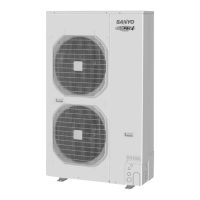1
1-122
SELECTING THE INSTALLATION SITE
CAUTION
When moving the unit during or after unpacking,
make sure to lift it by holding its lifting lugs.
Do not exert any pressure on other parts, especially
the refrigerant piping, drain piping and flange parts.
If you think the humidity inside the ceiling might
exceed 30
˚C and RH 80%, reinforce the insulation on
the unit body. Use glass wool or polyethylene foam as
insulation so that it is no thicker than 10 mm and fits
inside the ceiling opening.
Indoor Unit
AVOID:
Areas where leakage of flammable gas may be expected.
Places where large amounts of oil mist exist.
Direct sunlight.
Locations near heat sources which may affect the
performance of the unit.
Locations where external air may enter the room directly.
This may cause “condensation” on the air discharge ports,
causing them to spray or drip water.
Locations where the remote controller will be splashed with
water or affected by dampness or humidity.
Installing the remote controller behind curtains or furniture.
Locations where high-frequency emissions are generated.
Places where blocks air passages.
Places where the false ceiling is not noticeably on an incline.
DO:
Select an appropriate position from which every corner of the
room can be uniformly cooled.
Select a location where the ceiling is strong enough to
support the weight of the unit.
Select a location where tubing and drain pipe have the
shortest run to the outdoor unit.
Allow room for operation and maintenance as well as
unrestricted airflow around the unit.
Install the unit within the maximum elevation difference
above or below the outdoor unit and within a total tubing
length (L) from the outdoor unit as detailed in Tables 1-1
and 1-3.
Allow room for mounting the remote controller about 1m off
the floor, in an area that is not in direct sunlight or in the flow
of cool air from the indoor unit.
Places where optimum air distribution can be ensured.
Places where sufficient clearance for maintenance and
service can be ensured. (See the figures on the right side.)
AVOID:
Heat sources and exhaust fans, etc. (Fig. 1-4)
Damp, humid or uneven locations.
DO:
Choose a place as cool as possible.
Choose a place that is well ventilated and outside air
temperature does not exceed maximum 45˚C constantly.
Allow enough room around the unit for air intake/exhaust and
possible maintenance. (Fig. 1-7)
Use lug bolts or equal to bolt down unit, reducing vibration
and noise.
If cooling operation is to be used when the outdoor air
temperature is –5˚C or below, install a duct on the outdoor
unit.
Ceiling-Mounted Type
Fig. 1-3
Concealed-Duct Type / 4-Way Semi-Concealed Type
Fig. 1-4
Wall-Mounted Type
Fig. 1-5
Fig. 1-6
Ceiling
Wall
Font view
min. 25 cm
min. 25 cm
NOTE
The rear of the indoor unit can be installed flush against
the wall.
Air intake
Air
discharge
min. 50 cm
Side view
Max. 25 cm
Obstacle
1
m
1 m
1 m
1 m
1 m
min.
15 cm
Front View
min.
15 cm
min. 15 cm
Hot air
Exhaust fan
Out-
door
unit
Heat source
Outdoor Unit
SM830161Book.indb122SM830161Book.indb122 2008/06/039:08:122008/06/039:08:12

